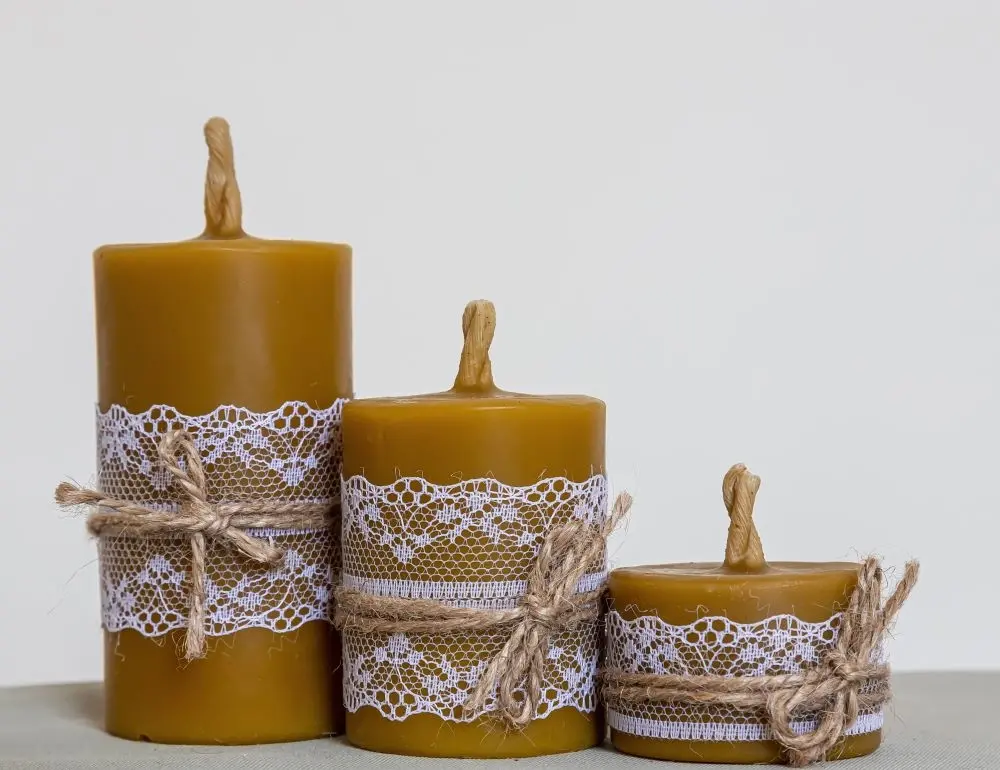Candlemaking is more than a craft; it is an art form that personalises spaces and enhances ambience, offering a soothing presence that uplifts well-being. This guide is designed for beginners to seasoned artisans eager to turn their passion for creating unique, artisan candles into a profitable home business.
Whether you want to add warmth to homes or craft unique gifts, selling candles online provides endless customisation possibilities. This guide will teach you the essentials of marketing, branding, and selling your candles. You will gain the tools to offer a healthier, more personalised alternative to commercial options while embracing your creativity and personal expression in candle making.
Benefits of Homemade Candles
Non-Toxic Materials: Many commercial candles use paraffin, a byproduct of petroleum refining that can release harmful chemicals when burned. Homemade candles, however, can be made from natural waxes like soy, beeswax, or coconut wax, which burn cleaner and are healthier for your indoor air quality.
Eco-Friendliness: By choosing eco-friendly and sustainable materials, homemade candles reflect a commitment to environmental stewardship. Natural waxes are biodegradable and often sourced from renewable resources, minimizing your ecological footprint.
Customisation: Offer the ability to customise scents, colours, and shapes, providing customers with products that match their decor or personal preferences, making each candle a unique addition to their space or a thoughtful gift.
Personal Touch: Homemade candles carry a personal touch that mass-produced candles cannot replicate. Each candle can hold a story, a memory, or a special intention, making it a meaningful part of your home or a thoughtful gift.
Aesthetic Appeal: Crafting candles allows for artistic expression. Whether embedding flowers, incorporating layers of different coloured waxes, or experimenting with rustic-looking textures, homemade candles can be true pieces of art that enhance the aesthetic of any space.
Stress Relief: The process of candle making can be incredibly therapeutic. Measuring, melting, and mixing provide a calming, meditative experience that can help reduce stress and promote mindfulness.
Creative Fulfillment: Engaging in creative activities like candle making can boost mental health and overall happiness. It offers a productive break from the digital screens and the hectic pace of daily life.
Starting Your Candle Business from Home
1. Business Setup and Legalities
Develop a Business Plan: Outline your business goals, target market, product lines, pricing strategy, marketing and sales strategies, and financial projections to serve as a roadmap and aid in funding pursuits.
Market Research: Conduct thorough research to understand the competition, identify your target audience, and pinpoint unique selling propositions such as speciality scents, eco-friendly materials, or custom designs.
Choose a Business Structure: Decide whether to operate as a sole proprietorship, partnership, LLC, or corporation, considering the implications for liability and taxes.
Business Registration: Register your business name with state authorities, and obtain necessary local, state, and possibly federal licenses and permits, including a business license and sales tax permit.
Insurance: Acquire business insurance to protect against liability and risks.
2. Product Development and Workspace
Choose Your Wax and Scents: Choose waxes such as soy, beeswax, or paraffin for their cost-effectiveness and performance qualities. Develop unique scent profiles to meet diverse consumer tastes.
Design and Testing: Design your candles to meet safety and performance standards, ensuring they comply with regulatory requirements and highlighting their long burn time and minimal soot production.
Workspace Requirements: Set up a safe, efficient production space in your home with the necessary tools like melting pots, thermometers, and scales and ensure compliance with local safety regulations.
3. Branding and Online Presence
Name and Logo Design: Choose a relevant business name and design a logo and packaging that reflects your brand’s ethos and appeals to your target audience.
Build an Online Presence: Create a professional website hosted by a reliable service like Verpex, with a unique domain. Ensure the site includes e-commerce capabilities for customers to browse and purchase securely, high-quality photos, detailed product descriptions, and is optimized for search engines.
4. Marketing and Sales
Social Media and Content Marketing: Utilize platforms like Instagram, Facebook, and Pinterest to engage customers and use content marketing strategies to educate your audience.
Local Markets and Events: Participate in local craft fairs and markets to build brand awareness and sell your products.
E-commerce Strategy: Use platforms like Amazon to sell your candles online, supported by effective digital marketing to drive traffic to your site.
5. Sales Management and Customer Service
Pricing and Fulfillment: Develop pricing strategies that cover costs while remaining competitive, and establish efficient order fulfilment processes including packaging and shipping.
Customer Service: Implement a customer service plan with clear policies on shipping, returns, and exchanges to encourage repeat business and gather positive reviews.
6. Business Management and Growth
Financial Oversight:Keep detailed financial records to monitor the health of your business.
Feedback and Adjustment: Use customer feedback to refine products and pricing, and consider expanding your product line to include complementary items like candle holders or home fragrance products.
Networking: Engage with local business groups and seek collaboration opportunities to expand your reach and influence.
Starting and running a candle business from home requires dedication and a well-organized plan, but with passion and careful execution, it can transform into a rewarding entrepreneurial journey.
Types of Homemade Candles

1. Container Candles
Container candles are the most common type of homemade candles. They are made by pouring wax into a container, typically a glass jar, tin, or ceramic pot, which also serves as the candle's packaging and mold.
They are easy to make, safe to burn, and highly customizable in size, scent, and colour, making them excellent gifts or decorative items.
2. Pillar Candles
Pillar candles are sturdy, free-standing candles that do not require a container. They are typically cylindrical but can come in various shapes and sizes. They have a longer burn time due to their larger size.
Pillar candles are excellent for decorating since they can be intricately carved or layered with different colours.
3. Taper Candles
Taper candles are long, slender candles that taper to a thinner point at the top. They are traditionally elegant and require a candle holder to burn properly. Ideal for formal settings such as dinner tables; they add a sophisticated touch to any setting.
4. Votive Candles
Votive candles are small, usually cylindrical candles designed to melt into a liquid in a tight container. They are often used to add ambience or for religious purposes. Shorter burn time makes them suitable for events like weddings or as bathroom accents. They are compact and can be grouped for decorative impact.
5. Tea Light Candles
Tea light candles are small, round candles encased in a thin metal or plastic cup. They provide a soft, subtle light and are often used in multiples. Extremely versatile, tea lights can be used in a variety of settings, from warm baths to outdoor lanterns.
6. Gel Candles
Gel candles are made from gelled mineral oils or synthetic hydrocarbons. They are transparent and allow for unique decorative elements, like embedded objects and vibrant colours. The transparency and the possibility to suspend items like shells, beads, or flowers inside make them highly decorative and appealing for gifts or display.
7. Beeswax Candles
Beeswax candles are made from all-natural beeswax. They burn very cleanly and exude a naturally sweet, honey-like fragrance. Eco-friendly and hypoallergenic, beeswax candles are ideal for those sensitive to synthetic fragrances and pollutants.
8. Soy Candles
Soy candles are made from soybean oil and burn cleaner and longer than paraffin candles. They are often preferred for their environmental benefits. They produce less soot and are renewable, biodegradable, and vegan-friendly.
Candle Care and Safety Tips
Candles add warmth, fragrance, and ambience to any space, but responsible usage is essential to ensure safety and prolong their lifespan.
Trim the Wick: Always trim the wick to about 1/4 inch to prevent a large flame, which can cause sooting and uneven burning.
Check for Debris: Remove any debris from the wax pool to prevent accidental fires.
Secure Placement: Place candles on a stable, heat-resistant surface away from drafts, children, pets, and flammable materials.
Monitor Continuously: Never leave a burning candle unattended. Always extinguish candles before leaving a room or going to sleep.
Use Candle Holders: Employ appropriate holders for taper and pillar candles to prevent tipping and catch dripping wax.
Maintain the Wick: Keep the wick centred and straight throughout the burn to ensure a consistent flame and minimize sooting.
Avoid Drafts: Position candles away from drafts, vents, and air currents to avoid rapid and uneven burning.
First Burn Memory: Allow a full wax pool to form on the first burn to prevent tunneling and ensure even burning on subsequent uses.
Limit Burn Sessions: Restrict burning to no more than 4 hours at a time. Allow the candle to cool for at least two hours before relighting.
After Use: Extinguish candles with a snuffer, clear debris from the wax pool, and allow them to cool completely before moving to prevent splattering of wax and burns.
Storage: Store candles upright in a cool, dry place away from direct sunlight and cover them to prevent dust accumulation and warping.
By following these tips, you can enjoy the beauty and ambience of your candles while ensuring they are used safely and efficiently.
Tailoring Scents and Styles for Every Season and Preference
Candles are not just sources of light; they are a sensory experience that can evoke memories, enhance moods, and personalize spaces. By offering customizable options, you can cater to a diverse clientele looking for that perfect home accent or gift.
1. Seasonal Customizations
| Season | Scents | Colours | Decorations |
|---|---|---|---|
| Spring | Opt for light floral and fresh scents like lavender, cherry blossom, or lemon grass. | Use pastel shades such as soft pink, light blue, and mint green. | Consider embedding flowers or using floral-themed labels and containers. |
| Summer | Focus on tropical or fruity fragrances like coconut, mango, or sea breeze. | Bright, vibrant colours like turquoise, sunny yellow, or coral red. | Additions like tiny shells or beach-themed ornaments can enhance the summer vibe. |
| Autumn | Warm and inviting spices such as cinnamon, pumpkin spice, or apple cider. | Rich autumnal colours like burnt orange, mustard yellow, and deep burgundy. | Incorporate elements like cinnamon sticks or dried leaves for an autumn feel. |
| Winter | Deep, warming scents such as pine, peppermint, or mulled wine. | Darker, richer tones or metallic shades like silver, gold, and navy blue. | Consider festive embellishments like glitter, snowflake imprints, or holiday-specific motifs. |
2. Personal Preferences
Custom Scent Blends: Offer customers the option to create their own scent blend from a selection of essential and fragrance oils. This can be a unique selling point and a fun interactive element of your business.
Colour Choices: Provide a colour mixing chart to help customers choose their preferred candle colours, whether they want a candle to match their home décor or represent their favourite colour.
Personalized Labels: Customers can add personal messages or names to the labels, making the candles perfect for gifts, weddings, or commemorative events.
Special Shapes and Sizes: Offer a variety of molds or the ability to request custom shapes and sizes, catering to those who might want something truly out of the ordinary.
Packaging Options: Create customizable packaging options for special occasions such as birthdays, anniversaries, or corporate events. This might include gift boxes, ribbons in specific colours, and themed decorative elements.
Conclusion
Starting a candle business from home blends creativity with entrepreneurship, providing a unique opportunity to craft products that cater to diverse preferences and occasions. Each candle enhances living spaces with its personalized touch and environmental friendliness.
By meticulously planning, adhering to legal requirements, and employing effective marketing strategies, you can establish a successful business that invites customers to appreciate the creation process and the enhanced ambience homemade candles offer. Dive into the possibilities of candle making and discover the styles that resonate most with you and your audience.
Frequently Asked Questions
How can I start a candle business from home?
To start a candle business from home, you need to decide on your business structure, create a business plan, identify your target market, and select the type of candles you want to make, such as soy candles or scented candles with essential oils. Gathering candle making supplies, such as soy wax, mason jars, and pouring pots, is also essential.
What are some effective strategies for selling candles online?
Selling candles online can be extremely profitable if you use the right strategies. Set up an online store on your own website or sell directly through marketplaces. Use interesting fragrances and decorative candles to attract potential customers. Invest in good photography and provide a behind-the-scenes peek to engage your audience.
How much money can I make selling candles from my own candle business?
The amount of money you can make from your own candle business varies widely. It depends on your candle price points, sales volume, and your target market. Selling mid-market or luxury candles online can particularly increase profits due to a wider customer reach.
What are the benefits of using soy wax in my homemade candle business?
Soy wax is a popular choice for homemade candle businesses because it burns cleaner than paraffin wax and is environmentally friendly. Soy candles are also easier to work with, making them a great option for beginners in the candle making industry.
Can I sell homemade candles at local markets and fairs?
Yes, you can sell homemade candles at local craft fairs, flea markets, and farmers markets. These venues are excellent for candle makers to start selling their products, allowing for direct interaction with customers buying candles and receiving immediate feedback.
What should I include in my candle business plan?
Your candle business plan should detail the types of candles you plan to sell, your business online strategy, anticipated shipping costs, and how you'll source candle making supplies like wax melts and candle wax. Additionally, include financial projections, marketing strategies, and any partnerships with wholesale suppliers or local stores.

Yetunde Salami is a seasoned technical writer with expertise in the hosting industry. With 8 years of experience in the field, she has a deep understanding of complex technical concepts and the ability to communicate them clearly and concisely to a wide range of audiences. At Verpex Hosting, she is responsible for writing blog posts, knowledgebase articles, and other resources that help customers understand and use the company's products and services. When she is not writing, Yetunde is an avid reader of romance novels and enjoys fine dining.
View all posts by Yetunde Salami




















